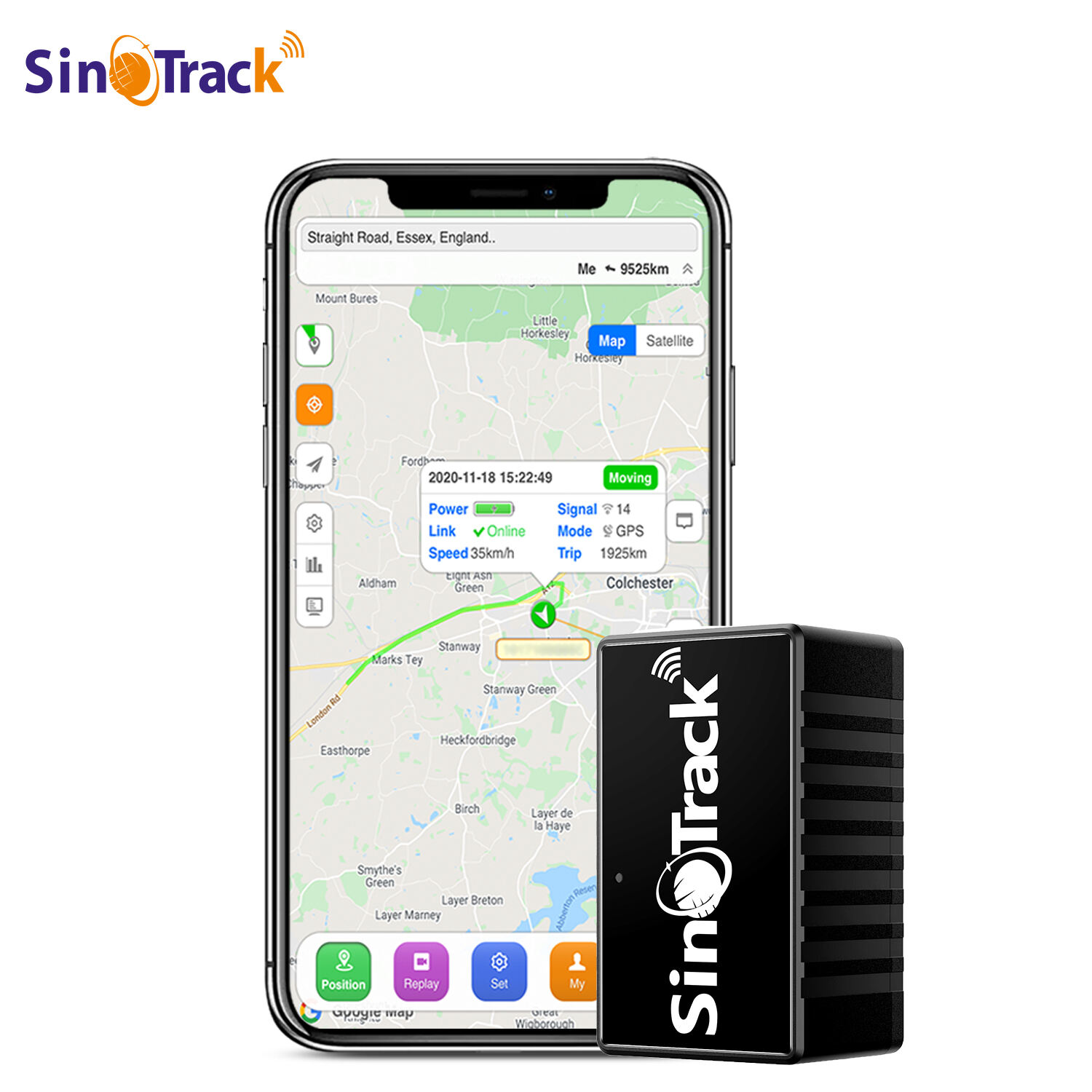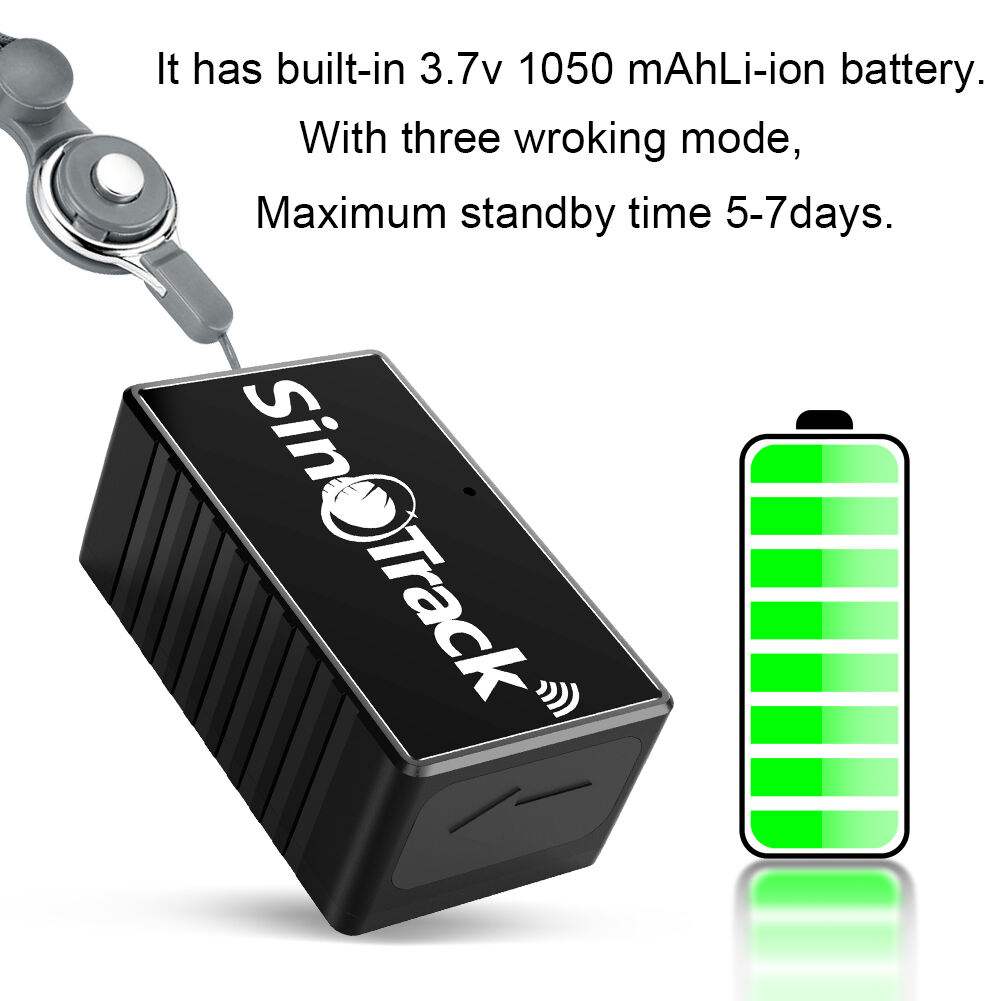Modern pet owners understand that keeping their furry companions safe requires more than traditional collars and tags. With millions of pets going missing each year, the demand for reliable pet gps trackers has skyrocketed as technology advances to provide real-time location monitoring and peace of mind. These sophisticated devices have evolved from bulky, battery-draining gadgets to sleek, efficient tracking solutions that seamlessly integrate into your pet's daily routine. Whether you have an adventurous dog that loves to explore or an indoor cat with occasional escape tendencies, investing in quality tracking technology can make the difference between a quick reunion and a prolonged, stressful search.

Understanding GPS Tracking Technology for Pets
How GPS Pet Trackers Function
GPS pet tracking devices operate using satellite technology combined with cellular networks to provide accurate location data. The device receives signals from multiple satellites to triangulate your pet's exact position, then transmits this information through cellular towers to your smartphone or computer. Most modern trackers update location data every few minutes, though some premium models offer real-time tracking with updates every 10-30 seconds. The accuracy typically ranges from 3 to 10 feet under optimal conditions, making it possible to locate your pet even in dense urban environments or wooded areas.
The tracking process involves several components working together seamlessly. The GPS receiver captures satellite signals, while the cellular modem transmits location data to cloud servers. Your mobile app or web dashboard then displays this information on interactive maps, often with additional features like location history, safe zone alerts, and activity monitoring. Battery life varies significantly between models, with some lasting several days while others require daily charging depending on update frequency and additional features like LED lights or sound alerts.
Types of Pet Tracking Systems
Several distinct types of pet tracking systems cater to different needs and budgets. Cellular-based trackers offer the widest coverage area, functioning anywhere with cell tower reception, but require monthly subscription fees for data transmission. Radio frequency trackers provide subscription-free operation with handheld receivers, though their range is limited to typically 1-5 miles depending on terrain and obstacles. Bluetooth trackers offer the most affordable option but only work within close proximity, making them suitable for indoor pets or short-range monitoring.
Hybrid systems combine multiple technologies for enhanced reliability and functionality. These advanced pet gps trackers might integrate GPS with Wi-Fi positioning for improved indoor accuracy, or combine cellular with radio frequency for backup communication when cellular coverage is poor. Some premium models also incorporate accelerometers and gyroscopes to monitor activity levels, health metrics, and behavioral patterns, providing comprehensive pet wellness insights beyond simple location tracking.
Essential Features to Consider
Battery Life and Charging Options
Battery performance stands as one of the most critical factors when selecting pet tracking devices. Most quality trackers offer 2-7 days of battery life under normal usage conditions, though this varies dramatically based on update frequency, additional features, and environmental factors. Devices with more frequent location updates naturally consume more power, while those with smart power management can extend battery life by reducing update frequency when pets remain stationary. Waterproof designs often sacrifice some battery capacity due to sealed construction requirements, creating a balance between durability and longevity.
Charging convenience significantly impacts daily usability and owner satisfaction. Magnetic charging ports eliminate the need for precise connector alignment while maintaining waterproof integrity, though proprietary cables can be problematic if lost or damaged. USB-C charging offers universal compatibility and faster charging speeds, while wireless charging pads provide ultimate convenience despite typically slower charging rates. Some advanced models feature solar charging capabilities or kinetic energy harvesting to extend battery life during outdoor activities, reducing the frequency of manual charging cycles.
Size, Weight, and Comfort
The physical dimensions and weight of tracking devices directly affect pet comfort and willingness to wear the device consistently. Small dogs and cats require particularly lightweight options, typically under 1.5 ounces, to prevent neck strain or behavioral changes. Larger dogs can accommodate bulkier trackers with extended battery life and additional features, but even big dogs benefit from streamlined designs that don't interfere with natural movement or play activities. The attachment method also influences comfort, with some pets preferring collar-mounted devices while others adapt better to harness-integrated systems.
Ergonomic design considerations extend beyond mere size and weight measurements. Rounded edges prevent chafing and irritation during extended wear, while breathable materials reduce skin issues in humid climates or during vigorous exercise. Adjustable mounting systems accommodate different collar widths and positions, ensuring secure attachment without creating pressure points. Premium models often feature hypoallergenic materials and antimicrobial coatings to maintain hygiene during long-term use, particularly important for pets with sensitive skin or allergies.
Top GPS Tracker Categories
Premium Full-Feature Models
Premium pet gps trackers offer comprehensive tracking capabilities with advanced features that justify higher price points. These devices typically include real-time tracking with 10-30 second updates, extensive battery life exceeding one week, and robust mobile applications with detailed analytics and customization options. Health monitoring features like activity tracking, sleep pattern analysis, and calorie counting provide valuable insights into pet wellness beyond simple location data. Many premium models also incorporate two-way communication systems, allowing owners to remotely trigger sounds or lights to help locate pets in immediate vicinity.
Advanced geofencing capabilities distinguish premium trackers from basic models, offering multiple customizable safe zones with sophisticated alert systems. These devices can differentiate between normal wandering and genuine escape attempts, reducing false alarms while maintaining security. Integration with smart home systems, veterinary software, and pet care apps creates comprehensive pet management ecosystems. Premium models often feature enhanced durability ratings, professional-grade waterproofing, and extended warranty coverage, making them suitable for working dogs, outdoor adventures, and harsh environmental conditions.
Budget-Friendly Options
Affordable tracking solutions make pet safety accessible to budget-conscious owners without compromising essential functionality. Basic GPS trackers typically offer standard location accuracy, reasonable battery life, and fundamental mobile app features at significantly lower price points. While they may lack advanced health monitoring or premium materials, these devices effectively provide peace of mind for everyday pet ownership scenarios. Subscription costs for cellular-based budget models are often lower, though with reduced data allowances or less frequent location updates.
Budget trackers excel in specific use cases where advanced features aren't necessary. Indoor cats that occasionally escape, elderly pets with predictable routines, or backup tracking for multiple pet households can benefit from simplified functionality. These pet gps trackers often feature longer battery life due to fewer power-consuming components, making them suitable for owners who prefer low-maintenance solutions. Some budget models use alternative technologies like radio frequency or Bluetooth to eliminate subscription fees entirely, though with corresponding limitations in range and functionality.
Installation and Setup Process
Initial Device Configuration
Setting up modern pet tracking devices has become increasingly user-friendly, with most manufacturers providing step-by-step mobile app guidance. The initial process typically involves creating user accounts, registering device serial numbers, and configuring basic pet information like breed, age, weight, and activity level. Cellular-based trackers require SIM card activation or subscription plan selection, which can usually be completed entirely through smartphone apps without calling customer service. Many devices arrive partially charged and ready for immediate testing, allowing owners to verify functionality before attaching to pets.
Customization options during setup significantly impact long-term user satisfaction and device effectiveness. Establishing appropriate geofences around home, workplace, and frequently visited locations prevents false alarms while ensuring security. Update frequency settings balance battery life with tracking precision based on individual pet behaviors and owner preferences. Notification preferences can be tailored to different scenarios, such as immediate alerts for escape situations versus daily summary reports for routine activity monitoring. Advanced models allow multiple user access with different permission levels, enabling family members or pet sitters to monitor without full administrative control.
Proper Attachment Methods
Secure attachment ensures consistent tracking performance while maintaining pet comfort throughout daily activities. Collar-mounted trackers require proper sizing to prevent device loss while avoiding excessive tightness that could cause discomfort or breathing restrictions. The general rule suggests fitting two fingers comfortably between collar and neck, with additional consideration for device weight distribution. Harness-integrated systems often provide more stable attachment points and better weight distribution, particularly beneficial for small dogs or cats that might be bothered by collar-mounted devices.
Regular inspection and maintenance of attachment systems prevent device loss and ensure ongoing pet safety. Collar wear, buckle integrity, and mounting hardware should be checked weekly, with particular attention after swimming, rough play, or outdoor adventures. Some tracking devices include backup safety features like breakaway collars or dual attachment points to prevent choking hazards while maintaining tracking capability. Professional fitting services offered by some manufacturers or pet stores can ensure optimal comfort and security, particularly valuable for difficult-to-fit pets or owners uncertain about proper attachment techniques.
Comparing Popular Brands
Market Leading Manufacturers
Several established companies dominate the pet tracking market, each offering distinct advantages and targeting different consumer segments. Whistle has built a reputation for comprehensive health monitoring integrated with location tracking, appealing to health-conscious pet owners who want detailed activity and wellness insights. Their devices typically feature longer battery life and robust mobile applications with veterinary integration capabilities. Fi focuses on adventure-ready designs with exceptional battery life and accurate tracking for active dogs, while maintaining sleek aesthetics that appeal to design-conscious consumers.
Jiobit targets families with multiple pets through simplified management interfaces and flexible subscription plans. Their devices emphasize ease of use and reliable basic functionality over advanced features, making them popular with less tech-savvy users. Link AKC combines GPS tracking with smart collar technology, offering premium materials and enhanced durability for working dogs and outdoor enthusiasts. Each manufacturer's approach reflects different philosophies about pet tracking, from comprehensive health ecosystems to simple, reliable location monitoring solutions.
Emerging Technology Companies
Innovative startups continue entering the pet tracking market with novel approaches and cutting-edge technology. Companies like Cube and Pawfit focus on ultra-compact designs with extended battery life through advanced power management algorithms. These newer entrants often leverage the latest cellular technology, including 5G and LTE-M networks, for faster data transmission and improved coverage in remote areas. Their agile development processes allow rapid feature updates and responsiveness to customer feedback that larger, established companies might struggle to match.
Emerging brands frequently offer competitive pricing strategies to gain market share, providing premium features at mid-range price points. Many incorporate artificial intelligence and machine learning to improve tracking accuracy, predict pet behavior patterns, and reduce false alarms through smart algorithms. Some startups focus on specific niches, such as tracking devices optimized for cats, elderly pets, or working animals with specialized requirements. The competitive pressure from these innovative companies drives industry-wide improvements in battery life, accuracy, and user experience across all price segments.
Real-World Performance Testing
Accuracy and Reliability Assessment
Independent testing reveals significant variations in real-world accuracy between different pet tracking devices, even those claiming similar specifications. Urban environments with tall buildings and dense cellular infrastructure can interfere with GPS signals, causing location drift or delayed updates that affect tracking precision. Forested areas, underground locations, and indoor spaces present additional challenges that separate premium trackers from budget alternatives. The best performing devices typically maintain accuracy within 10 feet under normal conditions, though this can degrade to 30-50 feet in challenging environments.
Long-term reliability testing demonstrates how various factors impact tracking performance over extended periods. Weather exposure, physical impacts from active pets, and battery degradation all influence device longevity and consistent operation. Professional testing environments simulate months of typical pet wear patterns, revealing which models maintain accuracy and functionality despite daily stress. Cellular network compatibility and roaming capabilities become crucial factors for pet owners who travel frequently or live in areas with limited carrier coverage.
Battery Performance in Real Conditions
Actual battery life often differs significantly from manufacturer specifications due to real-world usage patterns and environmental factors. Cold weather can reduce battery capacity by 20-30%, while frequent GPS updates in areas with poor cellular reception drain power more rapidly as devices boost transmission strength. Active pets generate more frequent location updates and trigger additional sensors, consuming more energy than sedentary animals. Testing reveals that typical usage patterns result in battery life approximately 20-40% shorter than laboratory conditions suggest.
Charging behavior and battery longevity vary considerably between different device designs and battery technologies. Devices with removable batteries offer the advantage of quick swapping but may sacrifice waterproof integrity, while sealed units provide better weather protection at the cost of charging convenience. Lithium polymer batteries generally offer better longevity and consistent performance compared to lithium-ion alternatives, though they typically cost more and may not be available in all device categories. Smart charging algorithms can extend overall battery lifespan by preventing overcharging and optimizing charge cycles.
Cost Analysis and Value Comparison
Initial Purchase Considerations
The upfront cost of pet gps trackers ranges dramatically from under fifty dollars for basic models to several hundred dollars for premium devices with comprehensive features. This initial investment should be evaluated against the potential costs of losing a pet, including veterinary bills for injuries, replacement costs for purebred animals, and emotional stress that money cannot quantify. Premium models often include extended warranties, superior customer support, and future software updates that provide ongoing value beyond the initial purchase price.
Budget allocation should consider the specific needs of individual pets and owners rather than simply choosing the cheapest or most expensive option. Active outdoor dogs may justify premium tracker investments through enhanced durability and extended battery life, while indoor cats might function perfectly well with basic tracking capabilities. Multi-pet households can benefit from bulk pricing or family plans offered by some manufacturers, reducing the per-device cost when tracking multiple animals simultaneously.
Ongoing Subscription Expenses
Monthly subscription fees for cellular-based tracking services represent the largest ongoing expense, typically ranging from ten to thirty dollars per month depending on features and data allowances. These recurring costs can exceed the initial device purchase price within the first year, making subscription terms and pricing a crucial factor in total cost of ownership calculations. Some manufacturers offer prepaid annual plans with significant discounts, while others provide family pricing for multiple devices under single accounts.
Subscription-free alternatives like radio frequency trackers eliminate ongoing fees but may require additional equipment purchases and have limited range capabilities. The total cost analysis should include potential savings from early pet recovery, reduced search efforts, and prevention of costly emergency situations. Premium subscription tiers often include additional services like veterinary consultations, lost pet recovery assistance, and extended customer support that provide value beyond simple location tracking functionality.
FAQ
How accurate are pet GPS trackers in different environments
Pet GPS trackers typically achieve accuracy within 10-30 feet under optimal outdoor conditions with clear sky visibility. Urban environments with tall buildings may reduce accuracy to 30-100 feet due to signal interference and multipath effects. Indoor accuracy is generally poor for GPS-only devices, though models with Wi-Fi positioning can improve indoor performance. Dense forest coverage, underground areas, and severe weather conditions can further impact accuracy, with premium models generally maintaining better performance in challenging environments through advanced antenna designs and signal processing algorithms.
What is the typical battery life of modern pet trackers
Battery life varies significantly based on tracking frequency, features used, and environmental conditions, typically ranging from 2-14 days for most devices. Basic trackers with infrequent updates may last up to two weeks, while real-time tracking models usually require charging every 2-5 days. Cold weather, poor cellular reception, and frequent use of LED lights or sound alerts can reduce battery life by 20-50%. Premium models often include power-saving modes that extend battery life during periods of inactivity while maintaining essential tracking functionality.
Are pet GPS trackers waterproof enough for swimming
Most quality pet GPS trackers feature IPX7 or IPX8 waterproof ratings, making them suitable for rain, puddles, and brief submersion during swimming activities. However, prolonged underwater exposure or deep diving may exceed design limitations and potentially damage electronic components. Salt water presents additional challenges due to corrosive properties, requiring thorough rinsing after beach or ocean exposure. Some manufacturers specifically design their devices for swimming pets, while others recommend removal during extended water activities to ensure device longevity.
Can multiple family members access the same pet tracker
Yes, most modern pet tracking systems support multiple user accounts with shared access to individual pet profiles. Primary account holders typically maintain administrative control over device settings, subscription management, and user permissions, while secondary users can view location data and receive notifications. Some platforms offer different permission levels, allowing pet sitters or family members limited access without full administrative privileges. Mobile apps usually support simultaneous login from multiple devices, enabling real-time collaboration during search efforts or routine monitoring activities.

